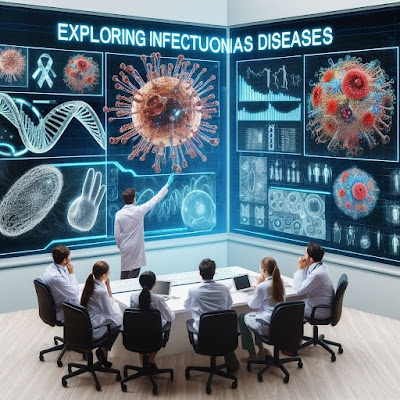Introduction:
Infectious diseases have shaped human history, from the devastating plagues of the past to the ongoing global challenges posed by emerging pathogens. In today's interconnected world, infectious diseases continue to pose significant threats to public health, with outbreaks ranging from seasonal flu to novel viruses like COVID-19. In this comprehensive guide, we will delve into the complex world of infectious diseases, exploring their causes, transmission, prevention, and treatment strategies.
 |
| Infectious Diseases |
Understanding Infectious Diseases:
Infectious diseases are caused by pathogenic microorganisms, including bacteria, viruses, fungi, parasites, and prions, that can invade the body and disrupt normal physiological functions.
These microorganisms can spread from person to person through various routes, such as respiratory droplets, contaminated food or water, insect bites, sexual contact, and direct contact with infected individuals or surfaces. Understanding the mechanisms of transmission is essential for implementing effective control measures and minimizing the spread of infectious agents.
Types of Infectious Diseases:
Infectious diseases encompass a wide range of conditions, each with its unique characteristics, symptoms, and modes of transmission. Common infectious diseases include respiratory infections (such as influenza, COVID-19, and tuberculosis), gastrointestinal infections (such as norovirus and salmonella), sexually transmitted infections (such as HIV/AIDS and gonorrhea), vector-borne diseases (such as malaria and dengue fever), and zoonotic infections (such as rabies and Ebola). The emergence of antimicrobial resistance poses additional challenges in the treatment of infectious diseases, highlighting the importance of prudent antibiotic use and infection control practices.
Epidemiology and Surveillance:
Epidemiology plays a crucial role in understanding the patterns and trends of infectious diseases, including their incidence, prevalence, and distribution within populations. Surveillance systems monitor and track infectious disease outbreaks, enabling early detection, rapid response, and targeted interventions to control the spread of disease. Epidemiological data also inform public health policies and guide resource allocation for disease prevention and control efforts.
Prevention and Control Measures:
Preventing infectious diseases requires a multifaceted approach that encompasses vaccination, hygiene practices, vector control, antimicrobial stewardship, and public health interventions. Vaccination is one of the most effective strategies for preventing infectious diseases, as it stimulates the immune system to produce protective antibodies against specific pathogens. Routine immunization programs have played a critical role in reducing the burden of vaccine-preventable diseases, such as measles, polio, and influenza. In addition to vaccination, simple hygiene measures, such as handwashing, respiratory etiquette, and food safety practices, can help prevent the spread of infectious agents and protect individuals from illness.
Treatment and Management:
The treatment of infectious diseases varies depending on the causative agent, severity of illness, and individual patient factors. Antibiotics, antiviral drugs, antifungal agents, and antiparasitic medications are commonly used to treat bacterial, viral, fungal, and parasitic infections, respectively. However, the emergence of antimicrobial resistance poses a significant threat to the effectiveness of these medications, highlighting the need for novel treatment approaches and alternative therapies. In addition to pharmacological interventions, supportive care measures, such as hydration, rest, and symptomatic relief, are essential for managing infectious diseases and promoting recovery.
Global Health Security and Preparedness:
In an interconnected world, infectious diseases can spread rapidly across borders, posing global health security threats that require coordinated international efforts to detect, respond to, and control outbreaks. The World Health Organization (WHO) plays a central role in coordinating global health responses, providing technical assistance, and mobilizing resources to address public health emergencies. Initiatives such as the International Health Regulations (IHR) framework aim to strengthen countries' capacities for disease surveillance, preparedness, and response, thereby enhancing global health security and resilience to infectious disease threats.
Emerging Infectious Diseases:
The emergence of novel infectious diseases, such as COVID-19, Ebola, Zika, and SARS, highlights the ongoing threat posed by emerging pathogens and the need for vigilance and preparedness. Factors driving the emergence of infectious diseases include environmental changes, such as deforestation and urbanization, globalization and travel, antimicrobial resistance, and zoonotic spillover events. Monitoring and surveillance of emerging pathogens, rapid diagnostics, research into novel therapeutics and vaccines, and coordinated international collaboration are essential for mitigating the impact of emerging infectious diseases and preventing future pandemics.
Conclusion:
In conclusion, infectious diseases remain a significant global health challenge, requiring collective efforts from governments, healthcare providers, researchers, and communities to prevent, detect, and control outbreaks. By understanding the mechanisms of transmission, implementing effective prevention measures, and investing in research and preparedness, we can mitigate the impact of infectious diseases and protect public health. As we continue to navigate the complex landscape of infectious diseases, collaboration, innovation, and resilience will be key to overcoming future challenges and safeguarding the health and well-being of populations worldwide.








